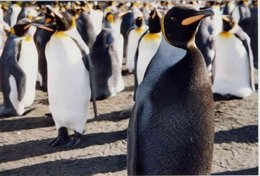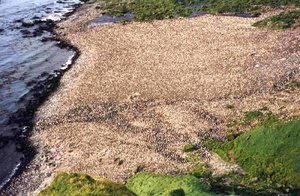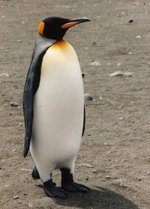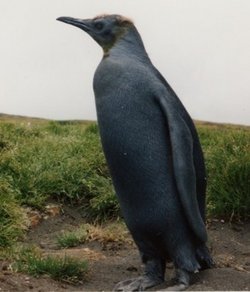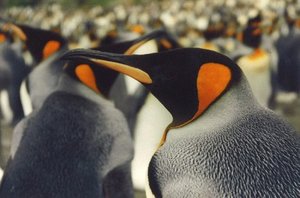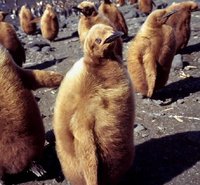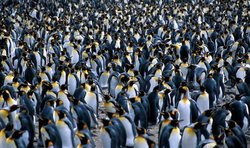King penguin

King Penguin on Saunders Island (By Liam Quinn from Canada (http://creativecommons.org/licenses/by-sa/2.0), via Wikimedia Commons)
The King penguin (Scientific name: Aptenodytes patagonicus J. F. Miller, 1778) is one of seventeen species of flightless birds in the family of penguins. With the Emperor penguin, it forms the genus Aptenodytes or "Great penguins."
|
Conservation Status |
|
Scientific Classification Kingdom: Animalia |
Like all penguins, the King penguin is characterized by its erect posture, stiff wings, excellent swimming ability, awkward movement out of water and distintive black and white coloring. That bicolor composition make penguins difficult to see when swimming, blending against the sea from above and the sky from below.
Contents
Physical Description
The King penguin is closely related to the Emperor penguin (Aptenodytes forsteri). Adult King penguins are smaller than Emperor penguins, measuring between 85 and 95 centimeters tall. Males are generally taller than females, otherwise they are appear the same (monomorphic). They weigh from 11 to 15 kilograms. King penguins have a rounded body, silvery-grey back, and a dark (blackish-brown) head. They are known for their bright-orange ear patch and for the bright-pink patch on the mandible, which is larger than that of Emperor penguins. They use their white and black flippers, or wings, for swimming and their black feet for walking on land, as they cannot fly. King penguins are more slender in the body and have a longer bill than Emperor penguins. Their dense plumage protects them from bitter, sub-Antarctic weather and consists of four layers: the outer layer is oily and waterproof and encloses three downy layers for insulation.
Diagnostic Description: Length: 94 cm. Plumage: Head, wings and tail black; belly white; back blue-grey; black line from back of head extending down sides separates grey back from white belly; bright orange patch behind ear extends into yellow-orange upper breast. Immature paler. Bare parts: iris dark brown; upper mandible black lower mandible black with red line at base; legs and feet black.
Reproduction
On arrival at a rookery, King penguins use a variety of ways to attract a mate. Males will open their flippers and emit a call while stretching its head up, throwing the head back, and finally bowing. A female then chooses the male she wants to mate with by answering his call. King penguins are monogamous within the breeding season and are likely to breed with the same mate over successive breeding seasons unless one of the pair dies.
King penguins have a long breeding season (14 to 16 months), compared to other penguin species. They breed twice every three years. Each time they breed they lay one egg. The breeding season for King penguins takes place during the winter. Eggs are laid anytime from November through April. The incubation period is around 54 days. It takes about 9 months for the chick to be fully fledged and up to 14 months to become independent.
When the female King penguin lays her egg, she delicately passes it to her mate. The male incubates the egg for about 19 days, while the female is foraging at sea. When the female returns, the parents take turns incubating the egg until hatching, with each parent spending two to three weeks at a time incubating the egg while the other is foraging. Once the chick has hatched, both parents take care of the young.
Penguin chicks are not able to regulate their body temperature when first hatched, they are brooded by both parents alternately. It takes about 3 weeks until the chick can be left alone. The parents take turns caring for the chick 3 to 4 days at a time. Once the chick is able to fend for itself, it joins neighboring chicks in a large group, or creche, for protection. Parents then bring their chick food every 2 to 3 days until the chick is fully fledged, in 43 to 60 weeks.
Lifespan/Longevity
The lifespan of the King penguin in the wild is not well known. Average lifespan in the wild is estimated at 15 to 20 years. The oldest King penguin in captivity reached 41 years old.
Behavior
King penguins form large groups on seven main islands in sub-Antarctic region. These colonies range in size from 30 to thousands of penguin pairs. Aptenodytes patagonicus is a highly social species, and individuals rarely fight.
Aptenodytes patagonicus moves on land by foot and moves through the water using its wings, more commonly known as flippers. Because of its sleek body frame, this penguin walks on land fairly well and does not hop around like Aptenodytes forsteri. King penguins breed on land and travel great distances from their rookeries to find food. They are well adapted to the sea because of their morphology; they use a lot less energy traveling underwater than on land.
When temperatures get too cold, these penguins increase metabolic heat production through shivering thermogenesis. In extremely cold temperatures these penguins also huddle together in rookeries, protecting both themselves and the young from the cold.
When King penguins arrive and depart from a breeding colony, they use acoustic and visual signals to communicate to mates. Acoustic signals are courtship calls between mates. Visual signals consist of a series of bows and neck movements.
Distribution
King penguins are found on island groups in the sub-Antarctic region (the South Atlantic Ocean, Indian Ocean, and southwest Pacific Ocean), including islands south of Australia, Tasmania, New Zealand, and South Africa -including South Georgia, Kerguelen Island, Crozet Islands, and Prince Edward Islands. The limit of the breeding range is around 45 degrees south latitude to the Antarctic Convergence. King penguins do not migrate, instead individuals travel hundreds of kilometers away from breeding grounds to find food.
Habitat
King penguins establish breeding colonies on temperate-cool islands with low, bare ground (including beaches, backshores, valleys, and glacial moraines). These penguins are both terrestrial and aquatic: terrestrial while breeding in colonies and aquatic for purposes of finding food. In these colonies, the temperature is near to or below 10 degrees Celsius. Rarely are King penguins found on ice or snow covered grounds. They prefer to be close to the sea, allowing for a convenient food source.
Predation
King penguins are prey for Hydrurga leptonyx and Orca orcinus that wait beneath the surface of the water. Shorebirds, such as Stercorariidae, Chionis, and Macronectes giganteus, prey on King penguin eggs and young chicks while these are unattended by adults.
Food Habits
King penguins hunt in groups. They travel hundreds of kilometers to find food. During warm, summer conditions they find food 10 to 200 meters below the ocean surface. In the winter their prey move to deeper waters, requiring King penguins to dive deeper. King penguins fast while on land caring for their young and replenish their reserves through foraging trips. Their diet is composed mostly of fish and cephalopods.
Conservation Status
The King penguin (Aptenodytes patagonicus) is a species of least concern according to the IUCN. There are currently two million King penguin breeding pairs. They have been harmed by human-influenced disasters, such as oil spills.
Economic Importance for Humans
During the 19th and 20th centuries, poachers used King penguin oil, flesh, and eggs for fuel, food, and clothing. Laws against poaching were formed by the International Ornithological Congress in 1905 and by the Antarctic Treaty in 1959. There are no known adverse effects of Aptenodytes patagonicus on humans.
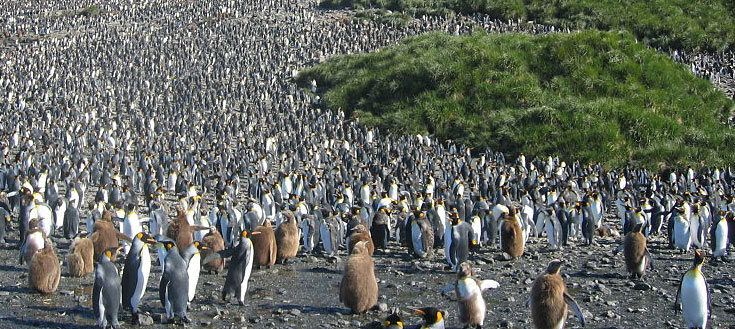 Content Source: Wikimedia Commons
Content Source: Wikimedia Commons
Further Reading
- Aptenodytes patagonicus J. F. Miller, 1778 Encyclopedia of Life (accessed March 26, 2009)
- Species 2000 & ITIS Catalogue of Life: 2009 Annual Checklist. Bisby FA, Roskov YR, Orrell TM, Nicolson D, Paglinawan LE, Bailly N, Kirk PM, Bourgoin T, Baillargeon G., eds (2009), Species 2000: Reading, UK.
- Aptenodytes patagonicus Korc, M. and A. Fraser. 2006. The Animal Diversity Web (online).(accessed March 26, 2009)
- King Penguin International Penguin Conservation Work Group (accessed March 26, 2009)
- King Penguin BirdLife International] (accessed March 26, 2009)
- WoRMS, World Registry of Marine Species (accessed March 26, 2009)
- IUCN Red List (accessed March 26, 2009)
- Global Register of Migratory Species (accessed March 26, 2009)
